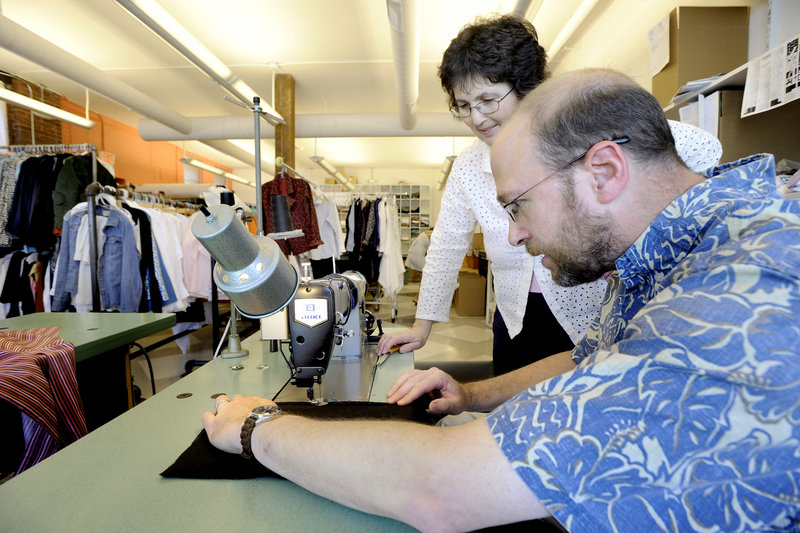PORTLAND – I was never very good at tracing stuff in kindergarten, but I never thought it would come back to haunt me.
Standing at a cutting table at Jill McGowan Inc. — a maker of designer clothing for women — I was handed a bunch of paper forms by veteran cutter Branka Bedak and told to trace them.
The forms were for various pieces of a casual women’s shirt called the “Laura.”
Bedak arranged the forms — one for the back, one for a cuff, one for the collar, etc. — on some navy and white striped crinkled-cotton fabric and then weighted down the form for the back with a heavy piece of iron.
Then she handed me a pencil and told me to trace the form.
I found that tracing with pencil on a crinkly cotton fabric is even tougher than tracing on paper. The pencil skipped away from the form and often got caught in little bunches of fabric. I thought the finished product looked like something I might have done in kindergarten.
“Oh that’s fine, that’s fine,” said Bedak, 44, as she used her pencil to finish off some lines I didn’t quite connect. “Here, I’ll give you a sharper pencil for the next one.”
Bedak’s job at the shop on Casco Street in downtown Portland is to cut fabric for the designer shirts, dresses and jackets Jill McGowan, Inc. sells in boutiques around the country and online. The shirts are mostly priced from about $150 to $250, while some jackets are more than $400.
Bedak does her cutting in the same room where company founder Jill McGowan does her designing.
Bedak starts her days with a series of order forms for various pieces of clothing. Some of the pieces she’ll cut are for special orders that will be shipped directly to boutiques. Others are prototypes that will be sent to larger clothing manufacturing sites and made in greater quantity, then shipped to stores.
The “Laura” shirt I was working on was size petite, and was a special order for a store in St. Helena, Calif. It retails for $260.
I’m glad I didn’t know that when I was dragging my pencil across the fabric. Or when I tried my hand at cutting.
After Bedak and I had traced a half-dozen or so pieces of the shirt, we started cutting. Bedak does most of her cutting with a powerful electric knife, with a circular blade, that almost looks like a mini-circular saw.
“Watch your fingers,” Bedak said just before I turned the knife’s motor on.
I was too busy trying to watch my faint pencil lines. There were areas where the line fell on a navy stripe and couldn’t see it at all. But for the most part, following the straight lines with the electric knife was easy. The circular cuts — which Bedak made with ease — came out pretty jagged when I tried.
And I found that when I had to switch to my left hand to cut, I couldn’t do it. So Bedak had to turn the pattern around for me.
It took me about five minutes to cut the shirt’s back panel, while I saw Bedak do similar pieces in a matter of seconds.
“Oh, when I started I was so nervous, I had never done it before,” said Bedak, who is originally from Bosnia. “But now it goes much faster.”
One of the things Bedak has to be careful of is to cut so that no pencil marks are left on the pieces. She also arranges all the pattern forms on one piece of fabric as close together as possible, to avoid wasting fabric.
When we were putting down the forms for the “Laura” it was like making a jigsaw puzzle. We jammed in smaller pieces, such as cuffs, collars, and inside lining pieces, among the backs, fronts, and sleeves.
About seven people work in the Jill McGowan, Inc. shop, making special orders and prototypes. After Bedak and I had cut the pieces for the “Laura,” I went to the area where the pieces would be sewn together. How the pieces are cut affects how they can be sewn together.
I went over to a single-needle sewing machine being operated by Bosiljka Injac, another native of Bosnia who has been a seamstress at the shop for 10 years.
McGowan had explained to me that her clothing is stitched in a “men’s tailoring tradition” using French seams for a clean look and single-needle stitching for strength.
Injac was working on a purple patterned jacked known as the “Bosa,” which is her nickname. McGowan has named pieces after all her employees, except the men, of course.
Injac let me sit at her machine and showed me how to fold over a half-inch section of the jacket to make a seam. Then she told me to just press the foot pedal and hold the fabric straight.
But this was no Singer portable, and when I stepped on the foot pedal the needle took off like it was powered by a V-8 engine.
I tried to keep the fabric straight but couldn’t. So I had to take my foot off the pedal and re-start a couple times, like a student driver.
I quickly gave the driver’s seat back to Injac and went back to see Bedak.
When it comes to making $260 pieces of clothing, I think tracing and cutting is more my speed.
Staff Writer Ray Routhier can be contacted at 791-6454 or at:
rrouthier@pressherald.com
Send questions/comments to the editors.



